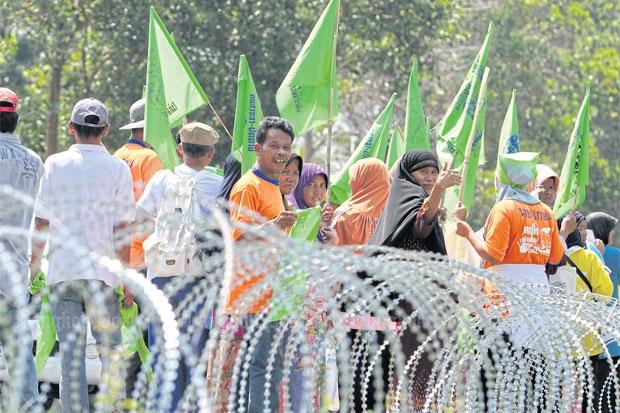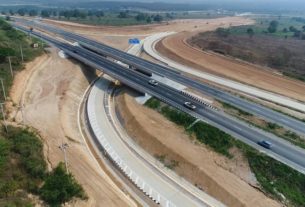
Over 100 villagers are barred from attending the public hearing on the coal-fired power plant in Thepa, Songkhla in July. Chanat Katanyu
Not only will 118 families, or some 500 people, in Songkhla’s Tepha district be evicted by the Egat coal-fired power plant, but it is also widely feared that the Gulf of Thailand’s ecosystem and the livelihoods of the people in the neighbouring districts in Songkhla and Pattani will be affected by sea contamination.
Those affected by the 2,000MW coal-fired power plant have complained they have barely been informed about the project’s advantages and disadvantages by Egat despite a series of public hearings, beginning on Nov 2 last year. Worse, they believe the hearing process is seriously flawed. For example, the villagers of Pattani’s Nong Chik district, who live some 8km away from the site but will also be affected by the power plant, have been excluded from the hearing.
They also allege Egat has offered giveaways of products such as rice to win support instead of giving much-needed information about the coal-fired power plant itself.
For project opponents, there is simply no space for them to air their grievances. Due to the order of the Songkhla governor, they were barred from entering the hearing venue on July 27-28.
However, the villagers claim that project supporters are being paid by Egat to turn up to show their support, at 500 baht per pick-up truck. There are also rampant allegations that the project operator brought in villagers from other districts to the hearing in order to make it look like the project has gained local support.
“The dubious and flawed process aside, the project itself poses a lot of questions,” said Somporn Chuai-Aree, Department of Mathematics and Computer Science, Faculty of Science and Technology, Prince of Songkla University’s Pattani Campus.
At the first and the third hearings, Mr Somporn submitted 60 points of concern to Egat which so far, he said, has yet to provide convincing and fair explanations.
His first question: why does the South needs power plants in Krabi and Songkhla as the current plants in Khanom (Nakhon Si Thammarat), Krabi, Chana (Songkhla), Rajaprapha Dam (Surat Thani), and Banglang (Yala) can produce 3,100MW, while consumption is at 2,700MW?
Another criticism is that a large amount of coal has to be imported for the project.
Mr Somporn, a core member of civic group Pattani Bay Watch, also argued that while Egat has attempted to downplay the impact, the affected areas could stretch to at least 2,960 rai of land, covering several tambons.
He said there were three areas that villagers were mostly worried about — the sea port construction, the residue landfill, and the huge amount of water that will be used for the plant’s cooling system.
The construction of the sea port with a thousand concrete columns erected in the sea will damage the habitats of small marine creatures — the source of income for tens of thousands of villagers in Tepha and nearby districts. Dozens of families who carry out aquaculture along the canal are being evicted to pave the way for coal boat feeders to get to inner areas.
The plant will use as much as nine million cubic metres of sea water each day in the cooling system. Egat promises that the water’s temperature will not be higher than three degrees above the normal level when it is released back to the sea. But the villagers still harbour doubts.
The changing temperature of the sea water will threaten the “homes” of small marine lives, which will destroy not only the ecology and but also livelihoods of thousands of fishers, said Mr Somporn.
He also voiced his concerns over coal ash. Under the planned management, the ash, totalling 23,000 tonnes per day, will be buried 10 metres deep in a landfill covered with plastic sheets covering 740 rai, or otherwise kept in a 10m-high concrete tank. The area can accommodate the ash for some 16 years — it remains unclear what will be done with the substance after that period.
“Tepha will have a huge amount of ash as a monument. But no one is reassured that the water in Tuyong Canal where mangroves stretch through the southern neighbouring district of Pattani’s Nong Chik will not be contaminated with the buried ash,” the scientist said.
Another grave concern, said Mr Somporn, is the standard of operations in case the dump site breaks or leaks. The damage could be great if the ash contains high level of sulphur.
“Anything that leaks into the sea in Tepha will be circulated throughout the Gulf and affect the livelihoods of small-scale fishermen in the coastal provinces as well as the capital and beyond,” said Mr Somporn.
Mr Somporn said renewable energy, from wind, sun, and waves, is a potential option for energy security in the southern region. If the controversial power plants in Krabi and Tepha were scrapped, Thailand could save the 200-billion-baht investment for alternative energy sources, and maintain the ecological balance.
“Laos is already dubbed the battery of Asia, and Vietnam and Myanmar will soon be nuclear producers. How about Thailand? Can we become a renewable energy hub?” Mr Somporn asked.
Charnmit Chaitem, a 61-year-old coastal fisher, has another question the government has yet to answer: “Is the junta returning happiness or sadness to the grassroots people? Don’t they think about protecting Tepha villagers from the influence of the insurgents? Pursuing this project will only widen community rifts and push the angry villagers to the other side.”
Achara Ashayagachat is Senior News Reporter, Bangkok Post.
Source: http://www.bangkokpost.com/opinion/opinion/748844/songkhla-project-puts-villagers-livelihoods-at-risk




